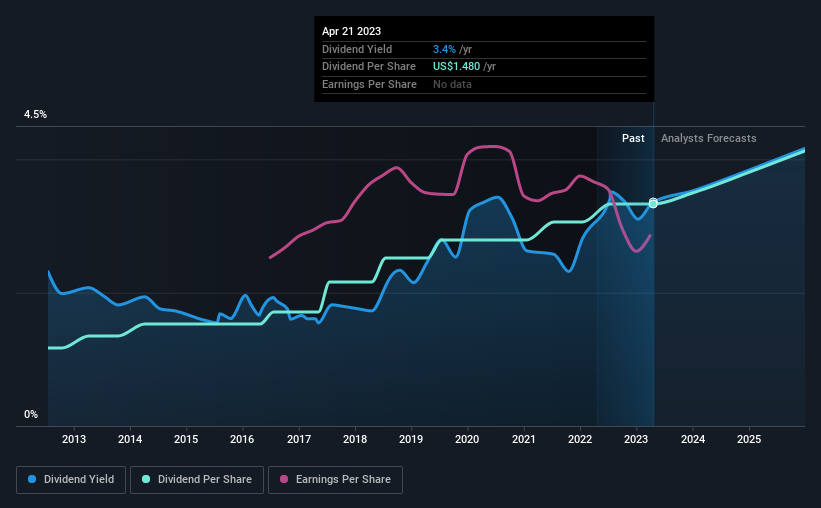The Bank of New York Mellon Corporation (NYSE:BK) Pays A US$0.37 Dividend In Just Four Days
Regular readers will know that we love our dividends at Simply Wall St, which is why it's exciting to see The Bank of New York Mellon Corporation (NYSE:BK) is about to trade ex-dividend in the next four days. The ex-dividend date occurs one day before the record date which is the day on which shareholders need to be on the company's books in order to receive a dividend. The ex-dividend date is of consequence because whenever a stock is bought or sold, the trade takes at least two business day to settle. Thus, you can purchase Bank of New York Mellon's shares before the 27th of April in order to receive the dividend, which the company will pay on the 11th of May.
The company's next dividend payment will be US$0.37 per share, on the back of last year when the company paid a total of US$1.48 to shareholders. Looking at the last 12 months of distributions, Bank of New York Mellon has a trailing yield of approximately 3.4% on its current stock price of $44.05. We love seeing companies pay a dividend, but it's also important to be sure that laying the golden eggs isn't going to kill our golden goose! So we need to investigate whether Bank of New York Mellon can afford its dividend, and if the dividend could grow.
See our latest analysis for Bank of New York Mellon
Dividends are typically paid out of company income, so if a company pays out more than it earned, its dividend is usually at a higher risk of being cut. Fortunately Bank of New York Mellon's payout ratio is modest, at just 46% of profit.
Companies that pay out less in dividends than they earn in profits generally have more sustainable dividends. The lower the payout ratio, the more wiggle room the business has before it could be forced to cut the dividend.
Click here to see the company's payout ratio, plus analyst estimates of its future dividends.
Have Earnings And Dividends Been Growing?
Companies with falling earnings are riskier for dividend shareholders. If earnings fall far enough, the company could be forced to cut its dividend. So we're not too excited that Bank of New York Mellon's earnings are down 2.8% a year over the past five years.
Many investors will assess a company's dividend performance by evaluating how much the dividend payments have changed over time. Bank of New York Mellon has delivered 11% dividend growth per year on average over the past 10 years.
To Sum It Up
Should investors buy Bank of New York Mellon for the upcoming dividend? Earnings per share have shrunk noticeably in recent years, although we like that the company has a low payout ratio. This could suggest a cut to the dividend may not be a major risk in the near future. At best we would put it on a watch-list to see if business conditions improve, as it doesn't look like a clear opportunity right now.
Wondering what the future holds for Bank of New York Mellon? See what the 13 analysts we track are forecasting, with this visualisation of its historical and future estimated earnings and cash flow
A common investing mistake is buying the first interesting stock you see. Here you can find a full list of high-yield dividend stocks.
Have feedback on this article? Concerned about the content? Get in touch with us directly. Alternatively, email editorial-team (at) simplywallst.com.
This article by Simply Wall St is general in nature. We provide commentary based on historical data and analyst forecasts only using an unbiased methodology and our articles are not intended to be financial advice. It does not constitute a recommendation to buy or sell any stock, and does not take account of your objectives, or your financial situation. We aim to bring you long-term focused analysis driven by fundamental data. Note that our analysis may not factor in the latest price-sensitive company announcements or qualitative material. Simply Wall St has no position in any stocks mentioned.
Join A Paid User Research Session
You’ll receive a US$30 Amazon Gift card for 1 hour of your time while helping us build better investing tools for the individual investors like yourself. Sign up here

 Yahoo Finance
Yahoo Finance 
